tow HONDA ODYSSEY 2018 Owner's Manual (in English)
[x] Cancel search | Manufacturer: HONDA, Model Year: 2018, Model line: ODYSSEY, Model: HONDA ODYSSEY 2018Pages: 763, PDF Size: 47.02 MB
Page 4 of 763
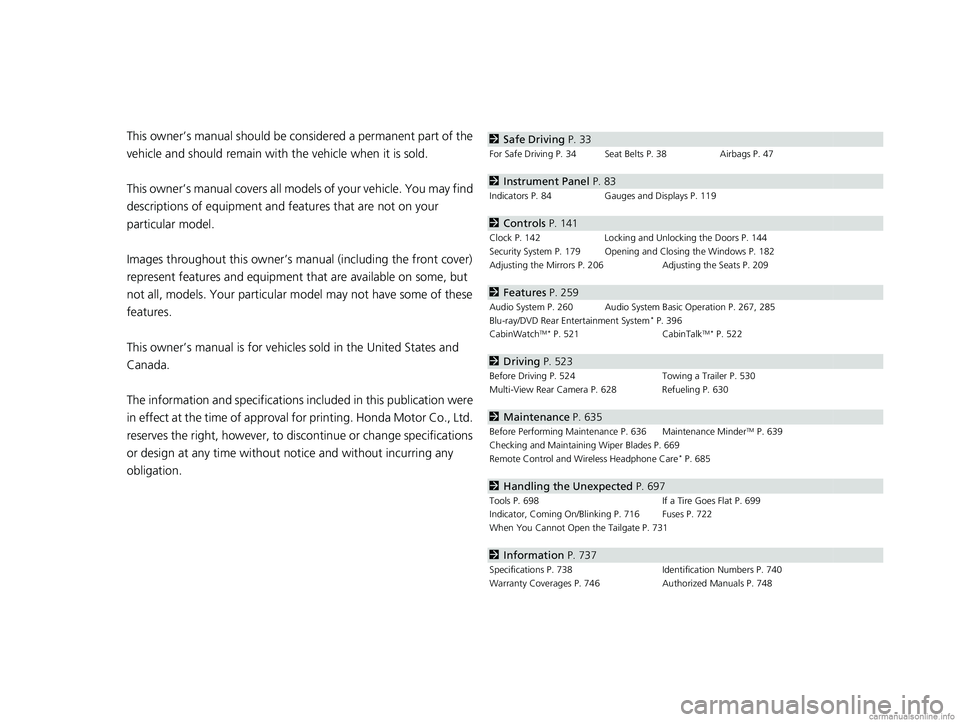
Contents
This owner’s manual should be considered a permanent part of the
vehicle and should remain with the vehicle when it is sold.
This owner’s manual covers all models of your vehicle. You may find
descriptions of equipment and features that are not on your
particular model.
Images throughout this owner’s manu al (including the front cover)
represent features and equipment that are available on some, but
not all, models. Your particular mo del may not have some of these
features.
This owner’s manual is for vehicles sold in the United States and
Canada.
The information and specifications in cluded in this publication were
in effect at the time of approval for printing. Honda Motor Co., Ltd.
reserves the right, however, to discontinue or change specifications
or design at any time without notice and without incurring any
obligation.2 Safe Driving P. 33
For Safe Driving P. 34 Seat Belts P. 38 Airbags P. 47
2Instrument Panel P. 83
Indicators P. 84 Gauges and Displays P. 119
2Controls P. 141
Clock P. 142 Locking and Unlocking the Doors P. 144
Security System P. 179 Opening and Closing the Windows P. 182
Adjusting the Mirrors P. 206 Adjusting the Seats P. 209
2Features P. 259
Audio System P. 260 Audio System Basic Operation P. 267, 285
Blu-ray/DVD Rear Entertainment System* P. 396
CabinWatchTM * P. 521 CabinTalkTM* P. 522
2Driving P. 523
Before Driving P. 524 Towing a Trailer P. 530
Multi-View Rear Camera P. 628 Refueling P. 630
2 Maintenance P. 635
Before Performing Maintenance P. 636 Maintenance MinderTM P. 639
Checking and Maintaining Wiper Blades P. 669
Remote Control and Wireless Headphone Care
* P. 685
2 Handling the Unexpected P. 697
Tools P. 698 If a Tire Goes Flat P. 699
Indicator, Coming On/Blinking P. 716 Fuses P. 722
When You Cannot Open the Tailgate P. 731
2 Information P. 737
Specifications P. 738 Identification Numbers P. 740
Warranty Coverages P. 746 Authorized Manuals P. 748
18 US ODYSSEY-31THR6010.book 2 ページ 2018年12月6日 木曜日 午後4時18分
Page 5 of 763
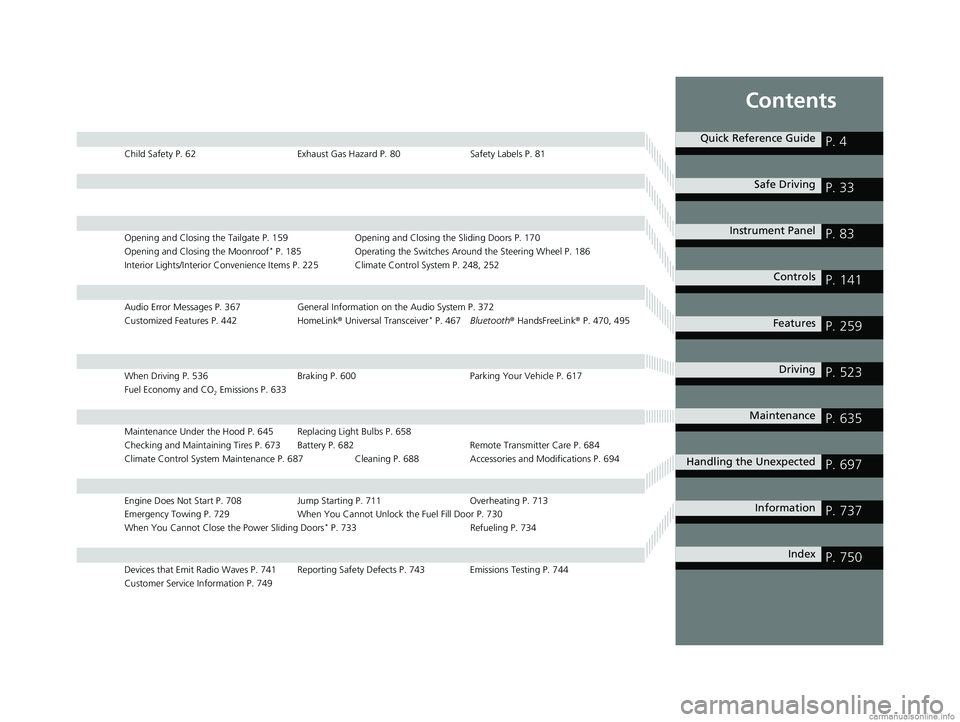
Contents
Child Safety P. 62Exhaust Gas Hazard P. 80Safety Labels P. 81
Opening and Closing the Tailgate P. 159 Opening and Closing the Sliding Doors P. 170
Opening and Closing the Moonroof* P. 185 Operating the Switches Around the Steering Wheel P. 186
Interior Lights/Interior Convenience Items P. 225 Climate Control System P. 248, 252
Audio Error Messages P. 367 General Information on the Audio System P. 372
Customized Features P. 442 HomeLink® Universal Transceiver* P. 467 Bluetooth ® HandsFreeLink ® P. 470, 495
When Driving P. 536 Braking P. 600Parking Your Vehicle P. 617
Fuel Economy and CO
2 Emissions P. 633
Maintenance Under the Hood P. 645 Replacing Light Bulbs P. 658
Checking and Maintaining Tires P. 673 Battery P. 682 Remote Transmitter Care P. 684
Climate Control System Maintenance P. 687 Cleaning P. 688 Accessories and Modifications P. 694
Engine Does Not Start P. 708 Jump Starting P. 711Overheating P. 713
Emergency Towing P. 729 When You Cannot Unlock the Fuel Fill Door P. 730
When You Cannot Close the Power Sliding Doors
* P. 733 Refueling P. 734
Devices that Emit Radio Waves P. 741 Reporting Safety Defects P. 743 Emissions Testing P. 744
Customer Service Information P. 749
Quick Reference GuideP. 4
Safe DrivingP. 33
Instrument PanelP. 83
ControlsP. 141
FeaturesP. 259
DrivingP. 523
MaintenanceP. 635
Handling the UnexpectedP. 697
InformationP. 737
IndexP. 750
18 US ODYSSEY-31THR6010.book 3 ページ 2018年12月6日 木曜日 午後4時18分
Page 10 of 763
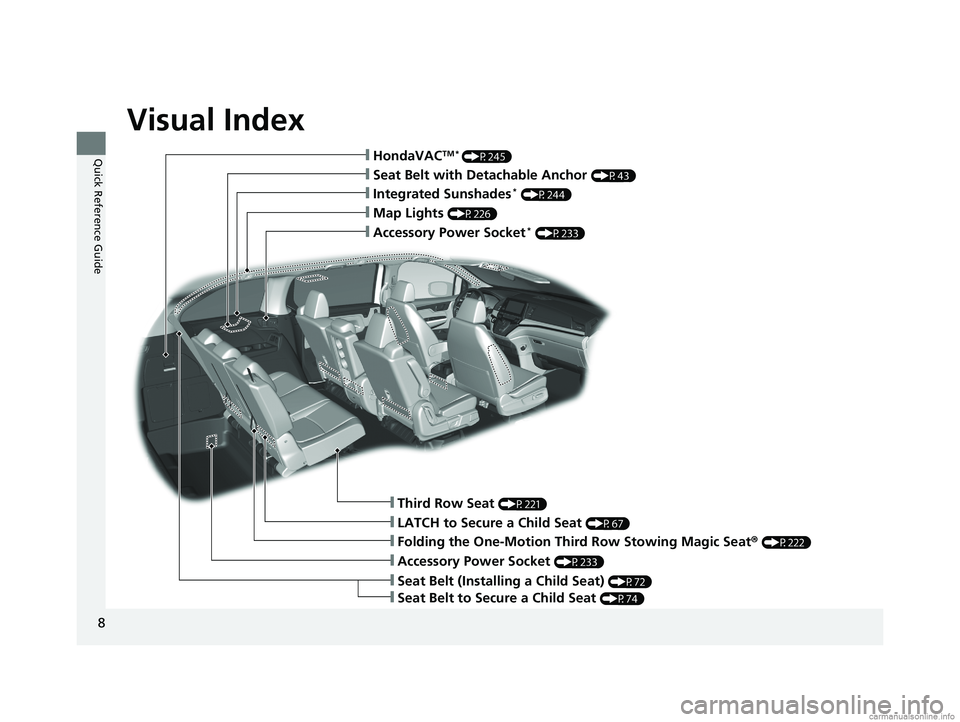
Visual Index
8
Quick Reference Guide
❙Accessory Power Socket* (P233)
❙Third Row Seat (P221)
❙Folding the One-Motion Third Row Stowing Magic Seat® (P222)
❙Integrated Sunshades* (P244)
❙HondaVACTM * (P245)
❙Map Lights (P226)
❙LATCH to Secure a Child Seat (P67)
❙Accessory Power Socket (P233)
❙Seat Belt (Installing a Child Seat) (P72)
❙Seat Belt to Secure a Child Seat (P74)
❙Seat Belt with Detachable Anchor (P43)
18 US ODYSSEY-31THR6010.book 8 ページ 2018年12月6日 木曜日 午後4時18分
Page 17 of 763
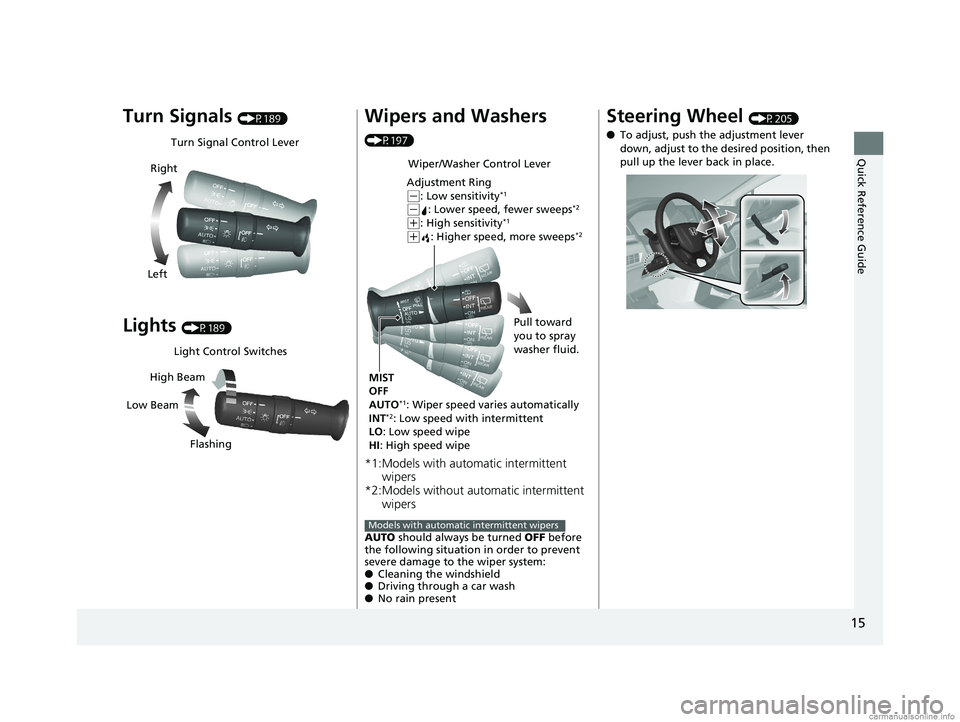
15
Quick Reference Guide
Turn Signals (P189)
Lights (P189)
Turn Signal Control Lever
Right
Left
Light Control Switches
Low Beam High Beam
Flashing
Wipers and Washers
(P197)
*1:Models with automatic intermittent wipers
*2:Models without auto matic intermittent
wipers
AUTO should always be turned OFF before
the following situation in order to prevent
severe damage to the wiper system:
● Cleaning the windshield
● Driving through a car wash
● No rain present
Wiper/Washer Control Lever
Adjustment Ring
( -: Low sensitivity*1
(-: Lower speed, fewer sweeps*2
(+: High sensitivity*1
(+: Higher speed, more sweeps*2
MIST
OFF
AUTO
*1: Wiper speed varies automatically
INT*2: Low speed with intermittent
LO: Low speed wipe
HI : High speed wipe Pull toward
you to spray
washer fluid.
Models with automatic intermittent wipers
Steering Wheel (P205)
● To adjust, push the adjustment lever
down, adjust to the de sired position, then
pull up the lever back in place.
18 US ODYSSEY-31THR6010.book 15 ページ 2018年12月6日 木曜日 午後4時18分
Page 31 of 763
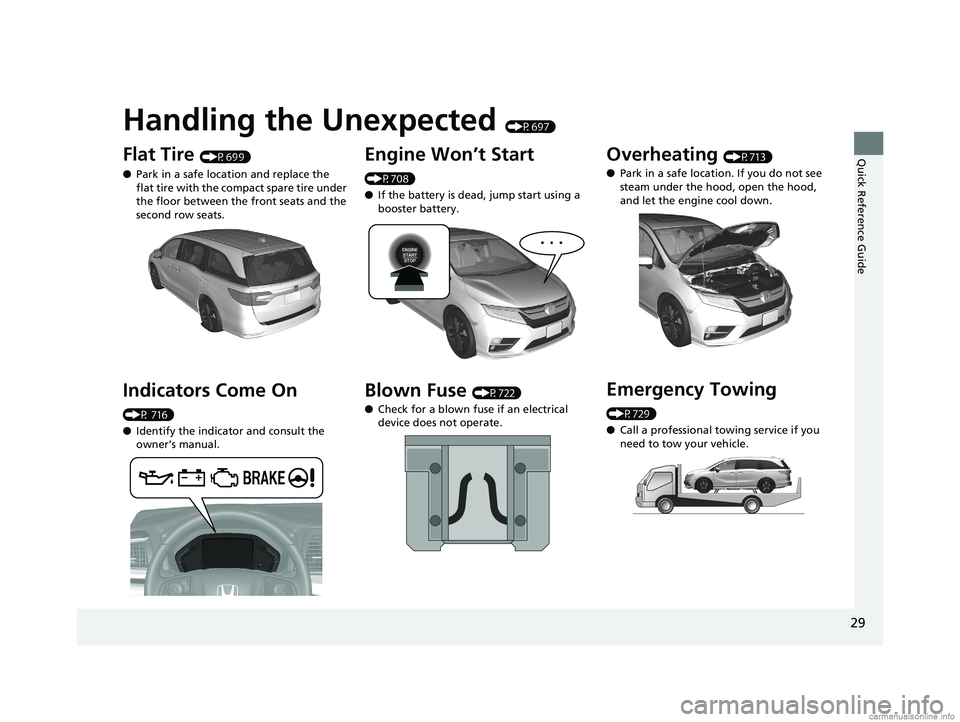
Quick Reference Guide
29
Handling the Unexpected (P697)
Flat Tire (P699)
● Park in a safe location and replace the
flat tire with the compact spare tire under
the floor between the front seats and the
second row seats.
Indicators Come On
(P 716)
●Identify the indica tor and consult the
owner’s manual.
Engine Won’t Start
(P708)
● If the battery is dead, jump start using a
booster battery.
Blown Fuse (P722)
● Check for a blown fuse if an electrical
device does not operate.
Overheating (P713)
● Park in a safe location. If you do not see
steam under the hood, open the hood,
and let the engine cool down.
Emergency Towing
(P729)
●Call a professional towing service if you
need to tow your vehicle.
18 US ODYSSEY-31THR6010.book 29 ページ 2018年12月6日 木曜日 午後4時18分
Page 44 of 763
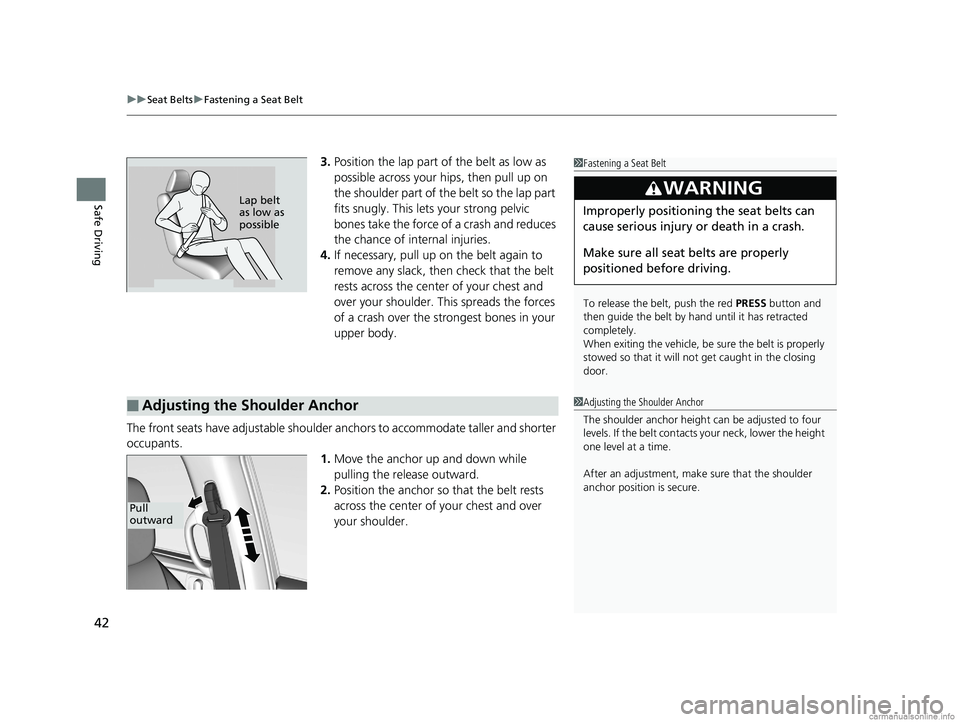
uuSeat Belts uFastening a Seat Belt
42
Safe Driving
3. Position the lap part of the belt as low as
possible across your hips, then pull up on
the shoulder part of the belt so the lap part
fits snugly. This lets your strong pelvic
bones take the force of a crash and reduces
the chance of internal injuries.
4. If necessary, pull up on the belt again to
remove any slack, then check that the belt
rests across the center of your chest and
over your shoulder. Th is spreads the forces
of a crash over the strongest bones in your
upper body.
The front seats have adjustable shoulder anchors to accommodate taller and shorter
occupants. 1.Move the anchor up and down while
pulling the release outward.
2. Position the anchor so that the belt rests
across the center of your chest and over
your shoulder.1Fastening a Seat Belt
To release the belt, push the red PRESS button and
then guide the belt by hand until it has retracted
completely.
When exiting the vehicle, be sure the belt is properly
stowed so that it will not get caught in the closing
door.
3WARNING
Improperly positioning the seat belts can
cause serious injury or death in a crash.
Make sure all seat belts are properly
positioned before driving.Lap belt
as low as
possible
■Adjusting the Shoulder Anchor1 Adjusting the Shoulder Anchor
The shoulder anchor height can be adjusted to four
levels. If the belt contacts your neck, lower the height
one level at a time.
After an adjustment, make sure that the shoulder
anchor position is secure.
Pull
outward
18 US ODYSSEY-31THR6010.book 42 ページ 2018年12月6日 木曜日 午後4時18分
Page 54 of 763
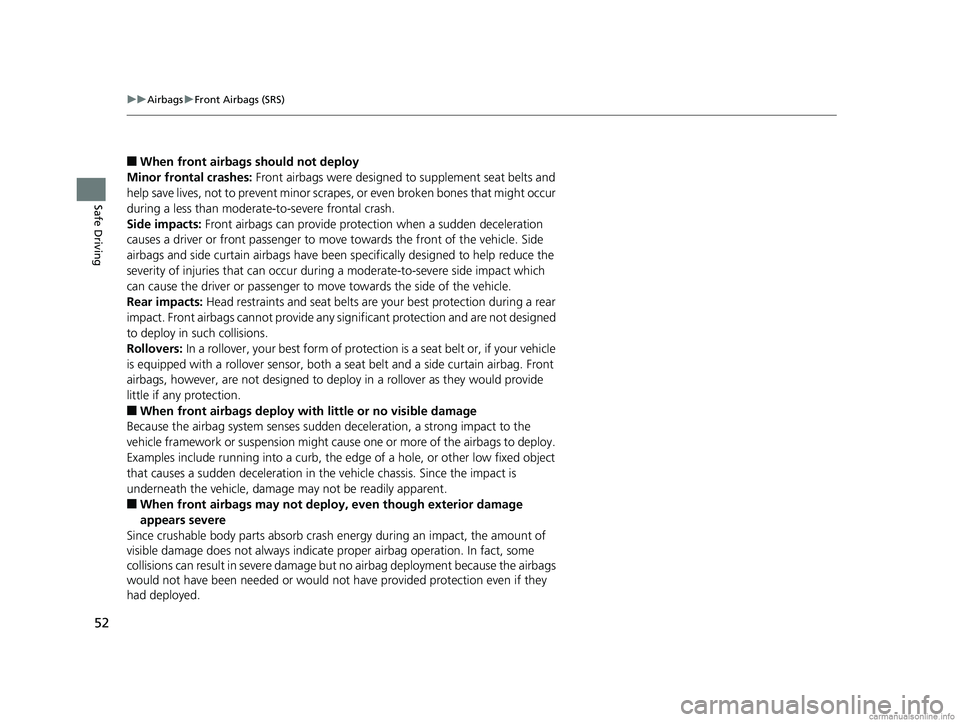
52
uuAirbags uFront Airbags (SRS)
Safe Driving
■When front airbags should not deploy
Minor frontal crashes: Front airbags were designed to supplement seat belts and
help save lives, not to prevent minor scrapes, or even broken bones that might occur
during a less than moderate-to-severe frontal crash.
Side impacts: Front airbags can provide protection when a sudden deceleration
causes a driver or front passenger to move towards the front of the vehicle. Side
airbags and side curtain airbag s have been specifically designed to help reduce the
severity of injuries that can occur durin g a moderate-to-severe side impact which
can cause the driver or passenger to move towards the side of the vehicle.
Rear impacts: Head restraints and seat belts are your best protection during a rear
impact. Front airbags cannot provide any si gnificant protection and are not designed
to deploy in such collisions.
Rollovers: In a rollover, your best form of protection is a seat belt or, if your vehicle
is equipped with a rollover sensor, both a se at belt and a side curtain airbag. Front
airbags, however, are not designed to deploy in a rollover as they would provide
little if any protection.
■When front airbags deploy with little or no visible damage
Because the airbag system senses sudden deceleration, a strong impact to the
vehicle framework or suspension might caus e one or more of the airbags to deploy.
Examples include running into a curb, the edge of a hole, or other low fixed object
that causes a sudden deceleration in th e vehicle chassis. Since the impact is
underneath the vehicle, damage may not be readily apparent.
■When front airbags may not deploy , even though exterior damage
appears severe
Since crushable body parts absorb crash energy during an impact, the amount of
visible damage does not always indicate proper airbag operation. In fact, some
collisions can result in severe damage but no airbag deployment because the airbags
would not have been needed or would not have provided protection even if they
had deployed.
18 US ODYSSEY-31THR6010.book 52 ページ 2018年12月6日 木曜日 午後4時18分
Page 55 of 763
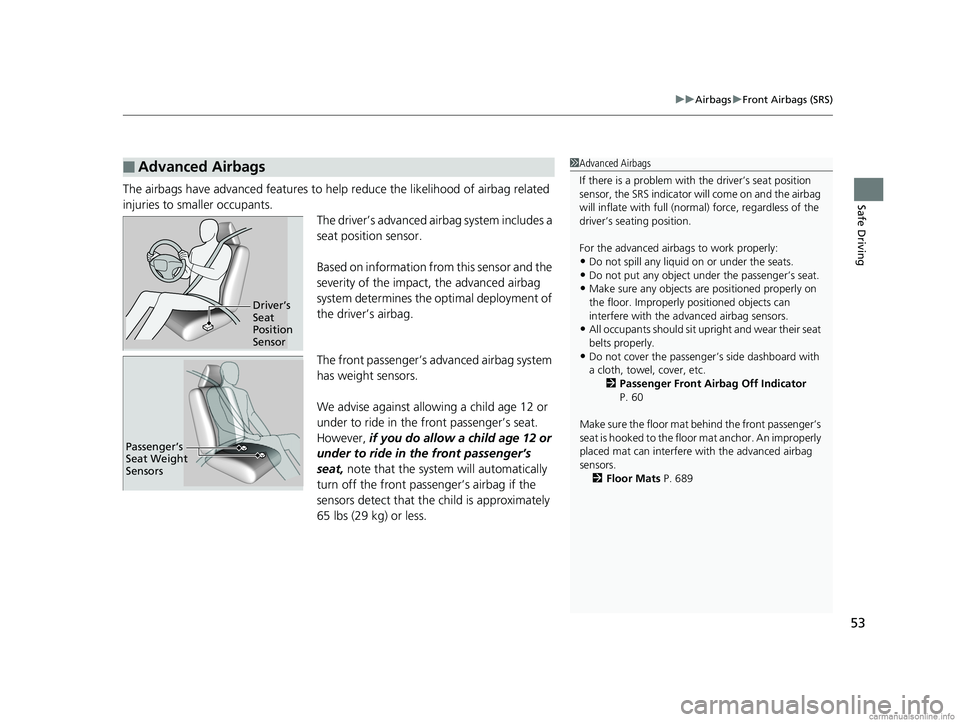
53
uuAirbags uFront Airbags (SRS)
Safe DrivingThe airbags have advanced features to help reduce the likelihood of airbag related
injuries to smaller occupants. The driver’s advanced airbag system includes a
seat position sensor.
Based on information from this sensor and the
severity of the impact, the advanced airbag
system determines the optimal deployment of
the driver’s airbag.
The front passenger’s ad vanced airbag system
has weight sensors.
We advise against allowi ng a child age 12 or
under to ride in the front passenger’s seat.
However, if you do allow a child age 12 or
under to ride in the front passenger’s
seat, note that the system will automatically
turn off the front passenger’s airbag if the
sensors detect that the child is approximately
65 lbs (29 kg) or less.
■Advanced Airbags1 Advanced Airbags
If there is a problem with the driver’s seat position
sensor, the SRS indicator wi ll come on and the airbag
will inflate with full (normal) force, regardless of the
driver’s seating position.
For the advanced airbags to work properly:
•Do not spill any liquid on or under the seats.•Do not put any object under the passenger’s seat.
•Make sure any objects are positioned properly on
the floor. Improperly pos itioned objects can
interfere with the advanced airbag sensors.
•All occupants should sit upri ght and wear their seat
belts properly.
•Do not cover the passenger ’s side dashboard with
a cloth, towel, cover, etc. 2Passenger Front Airbag Off Indicator
P. 60
Make sure the floor mat behind the front passenger’s
seat is hooked to the floor mat anchor. An improperly
placed mat can interfere with the advanced airbag
sensors.
2 Floor Mats P. 689
Driver’s
Seat
Position
Sensor
Passenger’s
Seat Weight
Sensors
18 US ODYSSEY-31THR6010.book 53 ページ 2018年12月6日 木曜日 午後4時18分
Page 59 of 763
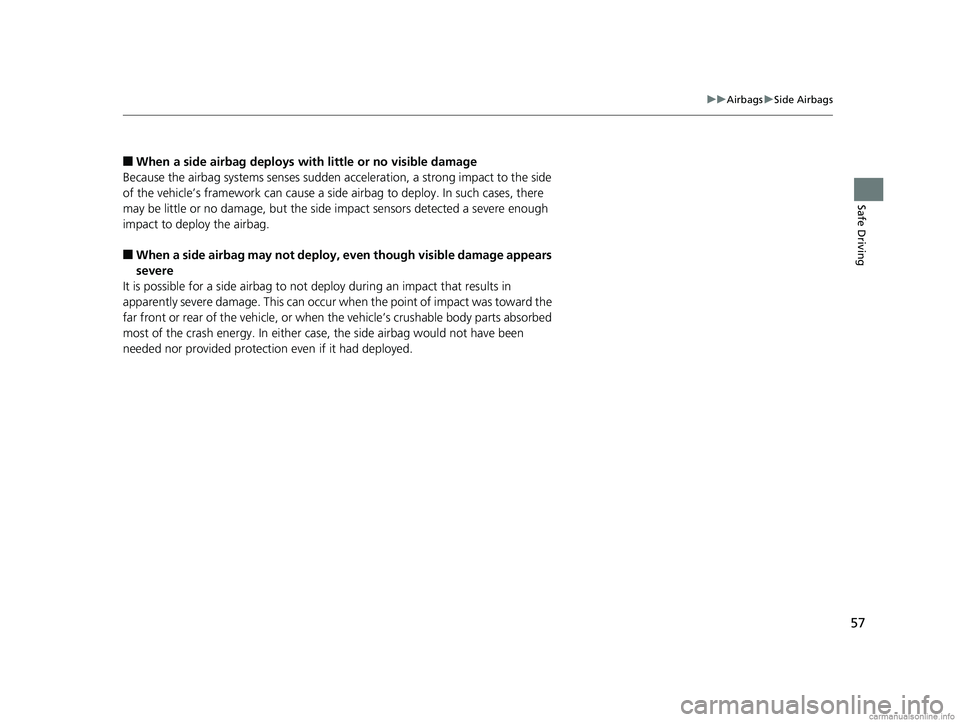
57
uuAirbags uSide Airbags
Safe Driving
■When a side airbag deploys with little or no visible damage
Because the airbag systems se nses sudden acceleration, a strong impact to the side
of the vehicle’s framework can cause a side airbag to deploy. In such cases, there
may be little or no damage, but the side impact sensors detected a severe enough
impact to deploy the airbag.
■When a side airbag may not deploy, even though visible damage appears
severe
It is possible for a side airbag to not deploy during an impact that results in
apparently severe damage. This can occur when the point of impact was toward the
far front or rear of the vehicle, or when the vehicle’s crushable body parts absorbed
most of the crash energy. In either case , the side airbag would not have been
needed nor provided protection even if it had deployed.
18 US ODYSSEY-31THR6010.book 57 ページ 2018年12月6日 木曜日 午後4時18分
Page 90 of 763
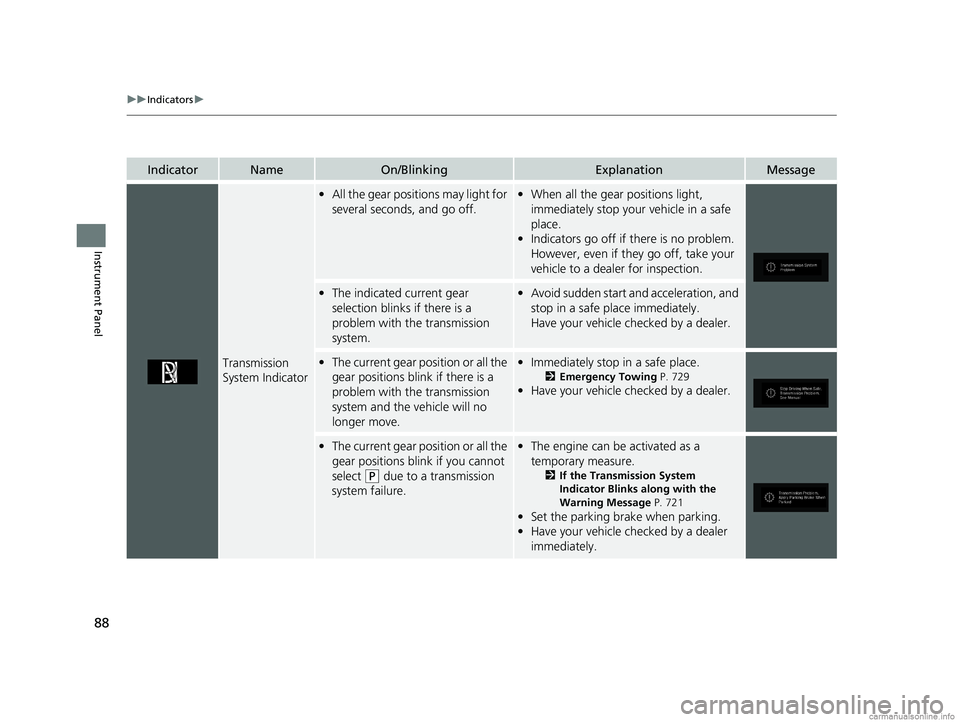
88
uuIndicators u
Instrument Panel
IndicatorNameOn/BlinkingExplanationMessage
Transmission
System Indicator
•All the gear positions may light for
several seconds, and go off.•When all the gear positions light,
immediately stop your vehicle in a safe
place.
• Indicators go off if there is no problem.
However, even if they go off, take your
vehicle to a dealer for inspection.
• The indicated current gear
selection blinks if there is a
problem with the transmission
system.•Avoid sudden start and acceleration, and
stop in a safe place immediately.
Have your vehicle checked by a dealer.
•The current gear position or all the
gear positions blink if there is a
problem with the transmission
system and the vehicle will no
longer move.•Immediately stop in a safe place.
2 Emergency Towing P. 729
•Have your vehicle checked by a dealer.
•The current gear position or all the
gear positions blink if you cannot
select
(P due to a transmission
system failure.
• The engine can be activated as a
temporary measure.
2 If the Transmission System
Indicator Blinks along with the
Warning Message P. 721
•Set the parking brake when parking.
• Have your vehicle checked by a dealer
immediately.
18 US ODYSSEY-31THR6010.book 88 ページ 2018年12月6日 木曜日 午後4時18分